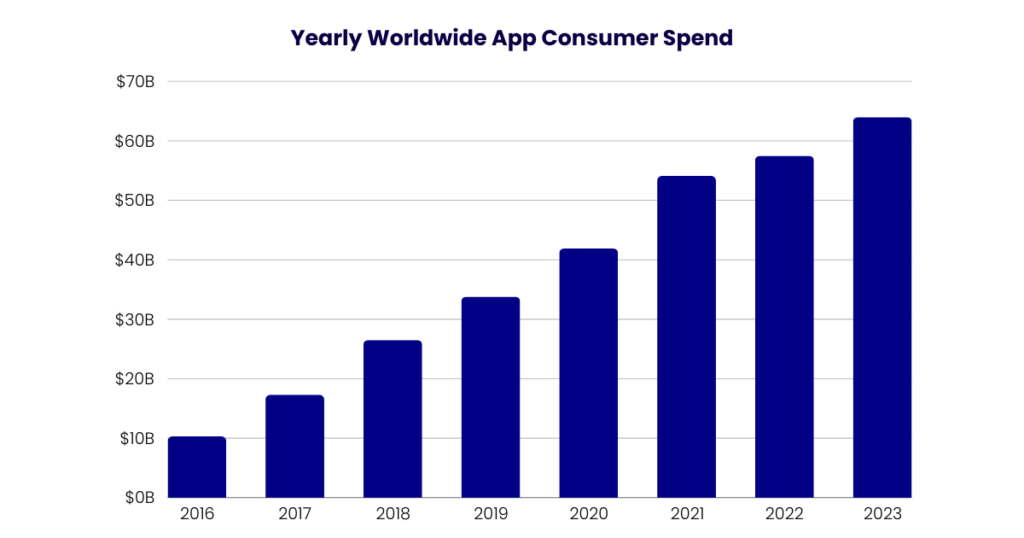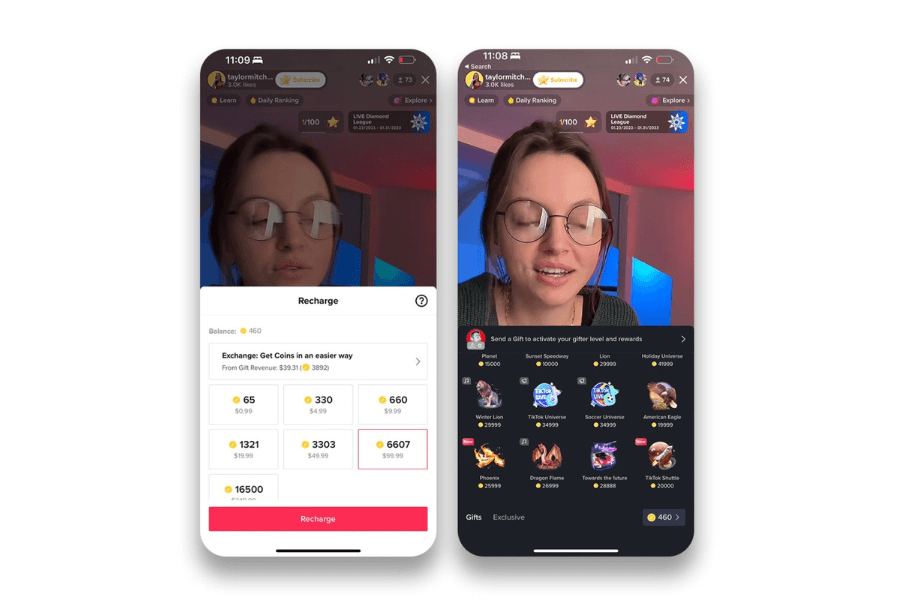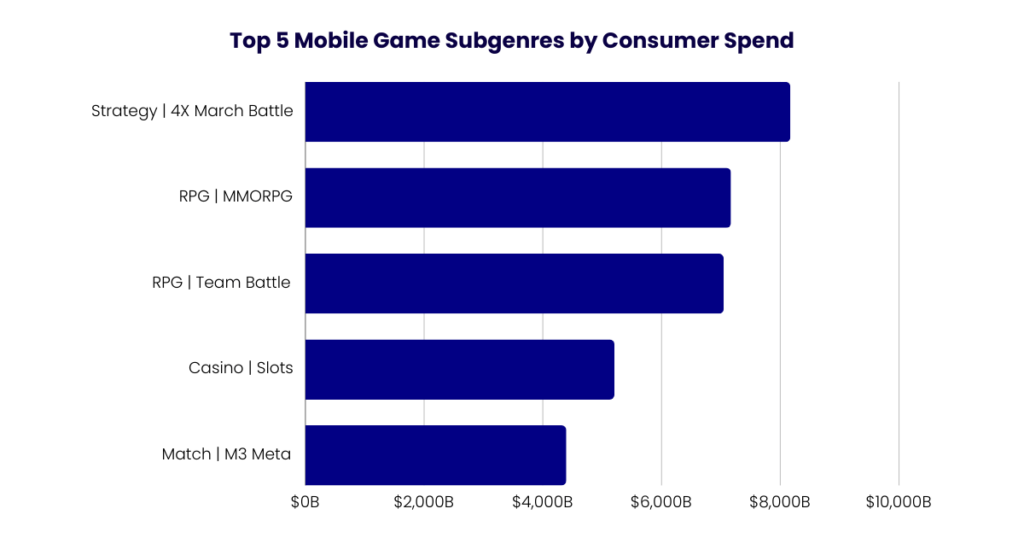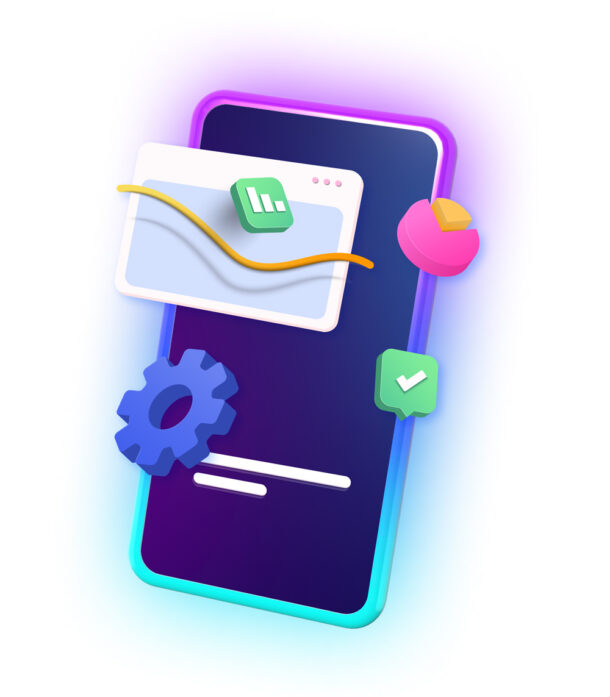The mobile ecosystem moves incredibly fast.
App monetization trends from just a year ago may already be outdated and ineffective. On the other hand, some come and persist for years.
But how do you keep up?
Listen to what the market is telling you.
The state of the app market is merely a reflection of the global economy and social trends.
To help you stay on top of things, we’ve listed the main app monetization trends you need to be aware of in 2024 & beyond!
1. Consumer Spending is Back on Track
In 2022, we witnessed the first-ever yearly decline in app consumer spending when it dipped by 2% (data.ai).
This was mainly caused by global inflation and reduced purchasing power.
As the worldwide economy began to recover, so did app consumer spending. In 2023, year-over-year app revenues increased by 3%, reaching $171 billion (data.ai).
The major part of this revenue comes from mobile games that grossed $107.3 billion, while other apps earned $64 billion.
Even though mobile games accounted for the majority of this revenue, consumer spending in this category actually decreased by 2% in the previous year.
Meanwhile, there is a positive trend among non-gaming apps where consumer spending is constantly increasing. In 2023, non-gaming app spending rose by 11% (data.ai).

This trend could be explained by user motivation for spending on apps and games.
Apps typically sell “need-to-have” services, making them more resilient to changes in purchasing power. Games, on the other hand, are more of a luxury expense, so people cut them when their finances are tight.
2. Entertainment Spending Spree
Wondering which types of non-gaming apps drive consumer spending?
The most lucrative non-gaming app categories are entertainment and social media apps. In 2023, entertainment app revenue went up by $1.72 billion, and social media revenue increased by $980 million.
There is one particular factor driving this trend — tipping systems.
Take TikTok as an example.
On TikTok, most users follow different content creators. The platform used this to its advantage, unlocking monetization solutions beyond advertising. This app pioneered a content creator tipping system, allowing users to donate to their favorite creators when live streaming.

By implementing this monetization strategy, TikTok became the first non-gaming app to reach $10 billion in revenue.
Apps like YouTube, Instagram, and Twitch adopted similar systems, boosting revenues across non-gaming apps and placing tipping systems among the most prominent app monetization trends.
3. Rise of Spending on AI Apps
Last year, AI made waves in the entire mobile industry, including app monetization.
In 2023, we’ve seen a major rise in generative AI apps. Alongside the ChatGPT app with 100+ million downloads, some other apps that gained popularity include Ask AI (20+ million downloads) and Character AI (10+ million downloads).
People are not only heavily downloading AI apps.
They are also spending money on them.
By late 2023, AI apps had reached $10 million in monthly consumer spending.
Most AI apps offer subscription options to unlock additional features. While most users find the basic versions of AI apps sufficient, people who use them for business and other important purposes are more likely to spend money on them.
This is just the beginning.
We believe that, in the years to come, spending on AI apps will play an even more important role in app monetization trends.
4. Mixing App Monetization Models
Today, most mobile apps no longer rely on a single revenue source. Instead, they leverage hybrid monetization.
To define, hybrid monetization is a mix of different app monetization models within a single app. For example, an app can monetize with in-app purchases, in-app ads, and subscriptions at the same time.

This trend has been around for a while and will remain one of the biggest app monetization trends in 2024 and beyond.
Purpose of hybrid monetization?
Getting the most out of each model.
The main benefit of hybrid monetization is being able to make money off a wide range of users. This way, your app’s revenues are not dependent on a single group of users. For example, ad viewers or buyers only.
This approach is gaining the most traction in gaming apps.
For instance, traditionally, casual games monetized with in-app purchases, while hyper-casual games made money through ads. Today, most games in both of these genres rely on hybrid monetization. Great examples of this are hit games like Subway Surfers by Sybo and Mob Control by Voodoo.
5. Further Rise of Rewarded Advertising
When we say you should throw ads into your monetization mix, this doesn’t mean you need to sacrifice the user experience.
If you’re going to combine revenue streams, we advise you to go for non-intrusive ad formats like rewarded video ads and offerwalls.

Using rewarded video ads in different apps and games has been a trend for years, showing no signs of slowing down. This ad format is non-intrusive, drives high eCMPs, and players enjoy it.
On the other hand, offerwalls are getting rediscovered as a monetization strategy.
This ad format has significantly evolved over the years, now delivering great UX and boosting user retention. According to Unity’s recent report, offerwalls users have up to 5x higher retention rates than non-offerwall users.
6. More Focus on First-Party Data
Data privacy changes have influenced all things mobile, including app monetization trends.
The introduction of Apple’s ATT has left in-app advertisers with limited data on users. This year, we’re also expecting the arrival of Google Privacy Sandbox, which will make things even more complicated.
As a result, targeted advertising has become much more challenging.
It’s both in the developers’ and advertisers’ best interest to show relevant ads to users. For this reason, they’ve started teaming up to collect first-party data.
First-party data is the data on app users collected by the developer. For example, the users’ activity overview, ad-watching habits, purchase history, registration data, etc.
In the privacy era, this information is gold.
As a result of this, more and more developers are using embedded analytics in monetization. To gather the first-party data correctly, they connect their analytics and mediation platforms.
7. Mid-Core Genres Drive Revenues
Just like entertainment apps drive revenues for non-gaming apps, mid-core games are the top earners among gaming apps.
This is one of those long-standing trends in app monetization.
According to Data.ai, the top mobile game genres by consumer spending in 2023 were strategy and RPG games. Precisely, 4X, MMORPG, and Team Battle subgenres.

The top-grossing mobile games of 2023 were Honor of Kings and PUBG Mobile, with $864 million and $636 million in revenue, respectively (Statista).
Why do people spend so much money on these games?
Mid-core players are known for their high engagement and monetization potential.
To cater to player needs, these games offer diverse monetization options, from power-ups to cosmetic purchases and battle pass subscriptions.
Finally, most games in these genres have multiplayer and competitive features. This gives players additional motivation to purchase in-game items to prove themselves among other players.
8. Further Rise of Real-Time Bidding
When you’re selling ad space in your app, you have two models to choose from — waterfall and real-time bidding (RTB).
In the waterfall model, the ad server goes through a predetermined list of ad networks, one by one. The rankings on this list depend on historical costs and performance. Then, the first ad network that meets the price floor wins the ad space.
It doesn’t even matter if there is a higher bidder lower on the list.
Sounds flawed?
It is. With this model, publishers are missing out on potential revenue. Advertisers, on the other hand, don’t get a fair chance to compete. For this reason, all sides are turning to real-time bidding.
The real-time bidding model brings more democracy, functioning as a unified auction. The rules of the auction are pretty simple — the highest bidder wins the ad space.
As a result, the publisher ends up getting higher eCPMs than from the waterfall model. According to Adjoe, publishers report that RTB has increased their overall app revenue by 60%.
The real-time bidding market has been steadily growing for years and isn’t showing signs of slowing down.
This market is predicted to grow from $15.6 billion in 2022 to $95.2 billion by 2032, at an annual growth rate of 19.8% (Future Market Insights).
App Monetization Trends Wrap-Up
Many app developers don’t do trend research. They wait until their competitors make a great move, and then they copy.
However, at this point, they are already miles behind.
If you consider yourself a strategic thinker, you don’t wait for your competitors’ next move. By analyzing the state of the mobile app market, you can recognize trends and patterns yourself.
Hopefully, this article on app monetization trends has made your work a bit easier.
Want to read more insightful articles like this one? Subscribe to our newsletter and stay up to date on all things mobile!







